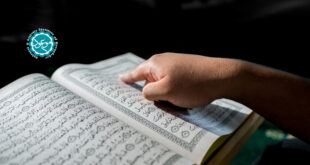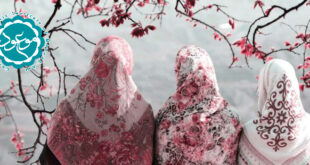Hijab literally means covering and is a type of clothing that covers a woman’s body. Islam instructs women to cover their bodies (except their hands and face) from non-mahram1 men.
The necessity of having Hijab can be extracted from Quranic verses and various Hadith. Here three verses on this issue are presented.
First Verse
Allah, Most High, has stated in the Quran:
“Tell the believing men to cast down their eyes (from indecent looks) and guard their modesty. This is purer for them. Surely Allah is aware of all they do. And tell the believing women to cast down their eyes (from indecent looks) and guard their modesty and refrain from revealing their adornments save those that are (naturally) manifest and cast their veils over their bosoms and not reveal their adornments save for their husband, father, husband’s father, sons, husband’s sons, brothers, brother’s sons, sister’s sons, their fellow women (in faith), their bondservants, their dependants (such as dullards) who do not have sexual desires, or children who do not know of women’s private parts; and they must not stomp their feet in order to reveal their hidden ornaments. And repent to Allah, O believers, haply you may attain bliss.”2
These verses pertain to the Hijab of women and contain several issues that must be expounded:
First, they ask the faithful, men and women, to secure their eyes and not leer. Men must not stare at women and women must not stare at men.
The word Ghudh [غض] means decreasing and closing. Ghudha basar means shortening one’s gaze and not staring. Sometimes, persons look at others and looking is not their purpose. At other times, people look lustfully at others for sexual pleasure; this is called leering. Leering is a cause for human corruption and thus it has been forbidden. However, looking without hedonistic desires is not forbidden (haram), because it is necessary for sociability and communal living.
Next, these verses direct men and women to guard their private parts [furuj]. Furuj is plural of farj which means pudendum [‘aurat]. Guarding one’s farj or covering it signifies preserving one’s chastity and modesty by ghudha basar—meaning not staring—and observing Hijab.
Then, they address women and declare:
“Do not reveal your adornments save those that are manifest.”
Zinat means adornment. There are various types of adornment. First are those that are detached from the body, such as earrings, necklaces, rings, hairclips, bracelets, and decorative clothes. Second are those that are applied to the body, such as eyeliner, nail polish, and hair color. Adornment spoken of in this verse encompasses both these types. Women are advised to eschew revealing their adornments for non-mahram men and thus prevent drawing the attention of men and arousing their sexual inclinations.
Next, the statement إلّا ما ظَهَرَ مِنها gives women permission to refrain from hiding their evident adornments—that are naturally obvious—such as Surmah (a specific type of natural eyeliner), eyebrow coloring, henna, rings, veil coloring, robes, and shoes. Since women are part of the society and have social responsibilities, naturally, non-mahram men see will certainly see their face, hands, and obvious adornments and covering these would be difficult. For this reason, Islam gives them permission to perform their duties without covering these.
Correspondingly, various Hadith also interpret adornments mentioned in this verse in this manner. Zurarah cited from Imam Sadiq (‘a) that he interpreted the words of God, إلّا ما ظَهَرَ مِنها, in the following manner:
“Manifest adornments consist of Surmah and rings.”3
Abubasir states:
“I asked Imam Sadiq (‘a) for the interpretation of God’s words, لا یُبدِینَ زِینَتَهُنَّ إِلَّا ما ظَهَرَ مِنها, he stated: Manifest adornments consist of rings and bracelets.”4
After speaking of Hijab the Quran states:
Khumur (خُمُر) is the plural form of khimar (خِمار) which is a kind of large veil or headscarf. Also, juyub is the plural form of jayb which means shirt collar.
It is said that at the time of the Prophet of Allah (S) women wore shirts that were open at the collar and revealed a portion of their breasts. Additionally, they put the sides of their headscarves behind their ears; therefore, their ears, earrings, neck, and a portion of their breasts were bared. Consequently, this verse directs women to cast their headscarves over their open neckline in order to cover their ears, earrings, neck, and breasts.
Tabarsi interprets this verse thus:
“Khumur (خُمُر) is the plural form of khimar (خِمار) which is a kind of veil or headscarf that falls over one’s neck and neckline. This verse instructs women to cast their headscarves over their breasts in order to cover their necks, since formerly, they would cast their headscarves behind their heads, which caused their breasts to be revealed.”5
Following this statement, the Quran states:
In order to completely observe modesty and prevent social corruption, women are advised to refrain from walking heavily to keep non-mahram men from hearing the sounds of their adornments. This is because such sounds may cause men to become sexually aroused and hence cause problems in the society, especially for youths and single men.
Several important ethical and Islamic issues can be derived from this verse:
1. Men and women (who aren’t married to each other) must abstain from visual indulgence and looking at each other in a lustful manner. People must not look at one another for sexual pleasure.
2. Women must not reveal their hidden adornments to men.
3. Women are obligated to wear their veil or headscarf in such a manner that their ears, earrings, their neck and the surrounding area, and their breasts are completely covered.
4. In order to honor public modesty and counteract moral corruption, women are advised to tread softly so the sounds of their steps do not cause corruption in men.
5. Women are not required to cover their obvious adornments.
Second Verse
Allah, the Exalted, has stated is the holy Quran:
“O Prophet! Tell your wives and daughters and believing women to draw their veils (cloaks) close unto themselves. This is better so that they may be recognized (as modest women) and therefore not be molested and Allah is much-forgiving and merciful.”6
The dictionary of Qamus defines jalbab (جَلْباب) as a loose shirt or garment for women or a garment worn on top of other clothes, which covers the other clothes completely. It is also defined as a veil or headscarf. Raghib has defined jalbab as a shirt and scarf in his book, Mufradat. Moreover, in Al-Munjid, jalbab is defined as a loose shirt or garment.
 Mouood Mouood English Edition
Mouood Mouood English Edition




